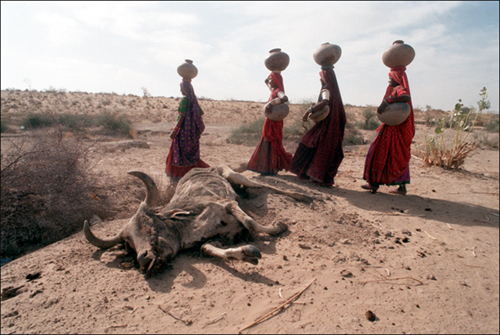 David Seaton's News Links
David Seaton's News LinksA News Links reader kindly sent me a link to this article in last September's New York Times as a comment to my last post on the "new" Indian economy. And it reaffirms me in my feeling that India's English speaking, computer savvy, "new middle class," may literally end up having to flee India for their very lives... And not in some far, distant, future.
And India is such a great and powerful and articulate place, in every sense, that such a collapse and such a catastrophe would be the "Berlin Wall" of globalization. DS
India, the Thirsty Giant - New York Times
Abstract: Bhanwar Lal Yadav, once a cultivator of cucumber and wheat, has all but given up growing food. No more suffering through drought and the scourge of antelope that would destroy what little would survive on his fields. Today he has reinvented himself as a vendor of what counts here as the most precious of commodities: the water under his land. Each year he bores ever deeper. His well now reaches 130 feet down.(...) Efforts like his — multiplied by some 19 million wells nationwide — have helped India deplete its groundwater at an alarming pace over the last few decades. The country is running through its groundwater so fast that scarcity could threaten whole regions like this one, drive people off the land and ultimately stunt the country’s ability to farm and feed its people. With the population soaring past one billion and with a driving need to boost agricultural production, Indians are tapping their groundwater faster than nature can replenish it, so fast that they are hitting deposits formed at the time of the dinosaurs. “What we will do?” wondered Pavan Agarwal, an assistant engineer with the state Public Health and Engineering Department, as he walked across a stretch of dusty fields near Mr. Yadav’s water farm. “We have to deliver water.” He swept his arms across the field, dotted with government wells. This one, dug 10 years ago, had already gone dry. In that one, the water had sunk down to 130 feet. If it were not for the fact that electricity comes only five hours a day, every farmer in the area, Mr. Agarwal ventured, would be pumping round the clock.(...) It was not always this way. Once farming made sense. Many of the women digging on a recent morning remembered growing their own food — peas, tomatoes, chili peppers, watermelons — and selling it, too, at the nearest town market. Year by year, the wells began to run dry. And there were several years of little to no rain. Meera, a mother of three who uses only one name, who is lucky enough to come from a landowning family, still watched her husband leave the village to find work in a cement factory. There were times, she acknowledged, when it became difficult to feed the children. Now she finds herself digging ponds for a bag of wheat. And praying for rain. “Our life is not life,” Meera said. “Only when it rains, there’s life.” READ IT ALL (bootleg)
2 comments:
Isn't Spain going the same way?
Yes and no. Spain is and has always been mostly a dry country, the exception being the northwest:Galicia, Asturias and the Basque Country. There is a great tradition of drought and coping with it.
The most important difference is in the density of population. India is notoriously over-populated, whereas Spain is under-populated. Spain has a population of 40m and experts say it could hold 60m easily. So that means there is some slack to cut before Spain finds itself in the situation we see in the NYT article.
Also, Spain has 700kms of frontier with France, not with Pakistan, China or Bangladesh and forms part of the European Union and that is a natural resource of incomparable value.
Post a Comment